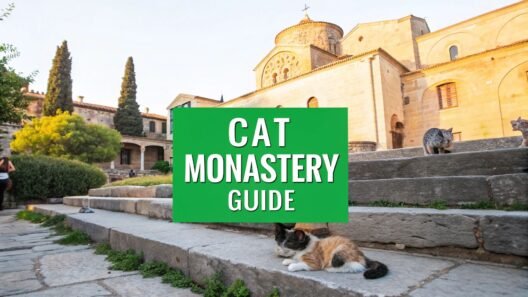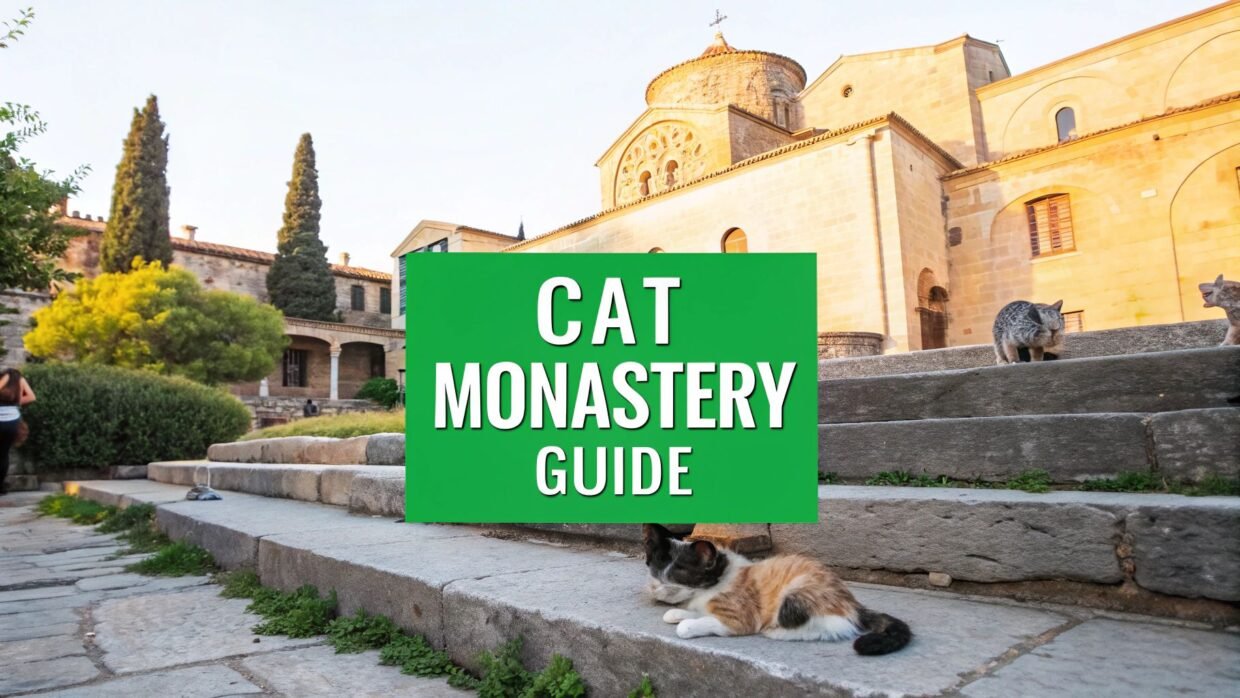On the sun-drenched coast of Cyprus, you'll find a sanctuary quite unlike any other, where faith and felines have lived side-by-side for centuries. The Holy Monastery of St Nicholas of the Cats, perched on the Akrotiri Peninsula, is a historical gem, known as much for its spiritual peace as for its legendary army of cat guardians. Let's delve into its fascinating story, from a land plagued by snakes to the tranquil convent it is today.
A Sanctuary of Faith and Felines in Cyprus
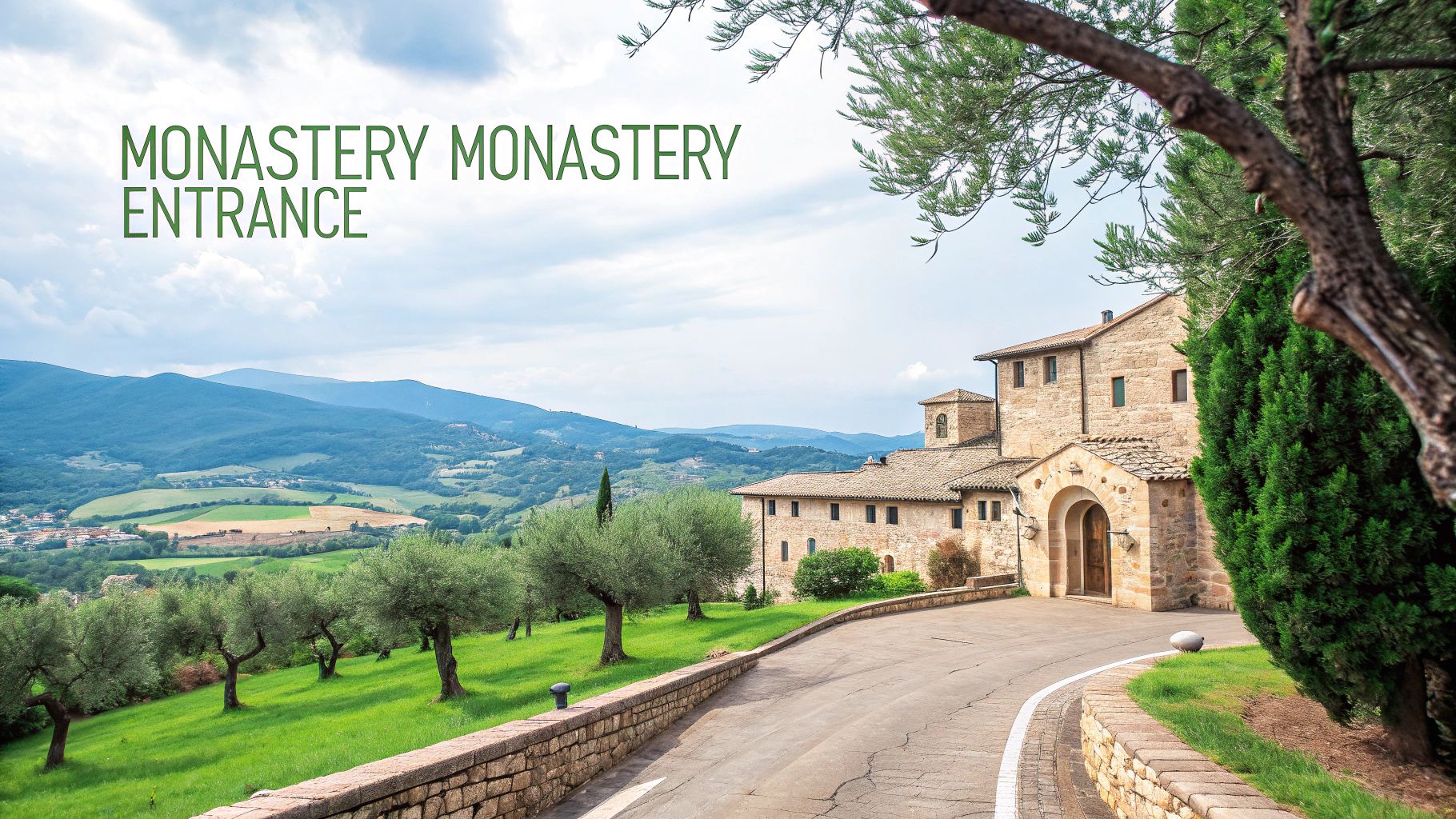
Picture a place where ancient stone walls seem to whisper tales of emperors, saints, and an ingenious solution to a rather slithery problem. That's the heart and soul of the Holy Monastery of St Nicholas of the Cats, one of Cyprus's most charming and beloved landmarks. It’s more than just a place of worship; it’s a living story, blending hard historical fact with enchanting local folklore.
The monastery's identity is tied to a powerful founding legend starring Saint Helena, mother of Emperor Constantine the Great. The story goes that when she landed in Cyprus back in the 4th century, she found the island in the grips of a terrible drought. Worse still, the land was overrun with venomous snakes, making life almost impossible for the locals. Her solution was as brilliant as it was unorthodox.
The Feline Guardians Arrive
To make the land safe for the monastic communities, Saint Helena is said to have shipped hundreds of cats over from Egypt and Palestine. These feline protectors were given a single, vital mission: hunt the snakes. This clever plan not only saved the area but also gave the monastery its wonderfully distinctive name.
This tale, passed down through the generations, explains the deep bond between the monastery and its resident cats. Even today, visitors are greeted by dozens of friendly felines lounging in the courtyards, proudly carrying on the legacy of their ancestors.
The monastery's historical importance isn't just a matter of legend; it’s well-documented and even attracted early European travellers. It sits in a unique spot, within the Akrotiri and Dhekelia Sovereign Base Area, which is a British Overseas Territory. Accounts from as far back as the late 15th century, like those from the Dominican friar Felix Fabri, paint a picture of an isolated religious site surrounded by green fields and orchards, confirming its long-standing reputation as a secluded spiritual haven. You can learn more about the monastery's historical context on WikiShire.co.uk.
The Legend of Saint Helena and the Snake-Hunting Cats
Every great place has its stories, but few are quite as charming as the one behind the Holy Monastery of St Nicholas of the Cats. This isn't just some historical footnote; it's the very reason the monastery exists, a fantastic tale mixing imperial power, a desperate ecological crisis, and a boatload of cats.
Our story kicks off way back in the 4th century with one of history's most influential women: Saint Helena, mother of Emperor Constantine the Great. She was on her way home to Constantinople after her famous quest to find the True Cross in Jerusalem when a vicious storm blew her fleet off course, forcing her to shelter on the coast of Cyprus.
An Island Overrun by Snakes
What she found was an island on its knees. Cyprus was in the grip of a devastating drought that had supposedly lasted for a staggering 17 years. The parched land had become a paradise for venomous snakes, which had multiplied to plague-like proportions, making vast swathes of the island virtually uninhabitable. People were abandoning their homes, and the countryside was ruled by serpents.
Saint Helena, determined to help the Cypriots reclaim their land and to found new monasteries, needed a solution. And the one she came up with was nothing short of genius.
At its heart, the legend is a brilliant example of ancient biological pest control. It’s a powerful story showing how people tackled real-world problems with the resources available, turning a common animal into a celebrated hero.
She commanded that ships be sent to Egypt and Palestine on a very specific mission: to gather hundreds, if not thousands, of cats. These weren't just any stray moggies; they were chosen for their skill as hunters. Upon their arrival in Cyprus, the feline army was deployed to the Akrotiri Peninsula, the future site of the monastery.
A Feline Army Goes to War
These cats had one job: hunt snakes. A local tradition, passed down through generations, claims the monks even trained them to a bell system. The first bell would ring to call the cats in for their food, and a second bell would send them back out into the fields to do their work. This disciplined platoon of predators went to war, systematically clearing the peninsula of its slithering menace.
They were so successful that the area was soon safe for humans again. In gratitude, the locals and the monks who settled there held the cats in the highest regard. The monastery that grew from this effort became forever tied to its furry protectors, earning the unique name it still carries today. The legend of Saint Helena's snake-hunting cats secured the monastery’s special place in Cypriot history and folklore, a story that continues to enchant visitors to this day.
A Look Back Through the Centuries
While the legend of the snake-hunting cats is a wonderful story, the monastery's documented history is a powerful tale of its own. This place has seen it all: prosperity, total abandonment, and a remarkable rebirth that mirrors the turbulent history of Cyprus itself. It's more than just an old building; it’s a survivor.
The monastery’s story really gets going in the 13th century. The church, which is the heart of the complex, was built during this time under Lusignan rule. It flourished, becoming a well-known and respected Orthodox institution, and continued to thrive when the Venetians took over. Records from that time paint a picture of a busy spiritual centre, a real beacon of faith on the otherwise isolated Akrotiri Peninsula.
From A Lively Hub to Silent Ruins
Things took a turn with the Ottoman conquest in the 16th century. Like so many other Christian sites across the island, the monastery fell on hard times. Its monks eventually left, and the once-vibrant community was abandoned. For hundreds of years, the stone walls were left to crumble in silence, with only the cats—the descendants of the original feline protectors—left to wander the grounds.
It wasn't until the 20th century that a serious effort was made to bring the old place back from the brink. This long restoration project gave the monastery a new lease of life, but with a twist. In 1983, it was officially re-established, not with monks, but as a convent for nuns. A small group of dedicated women moved in, breathing life back into the ancient stones and securing its spiritual purpose for the future.
This visual timeline really helps to put the monastery's long and often difficult history into perspective.
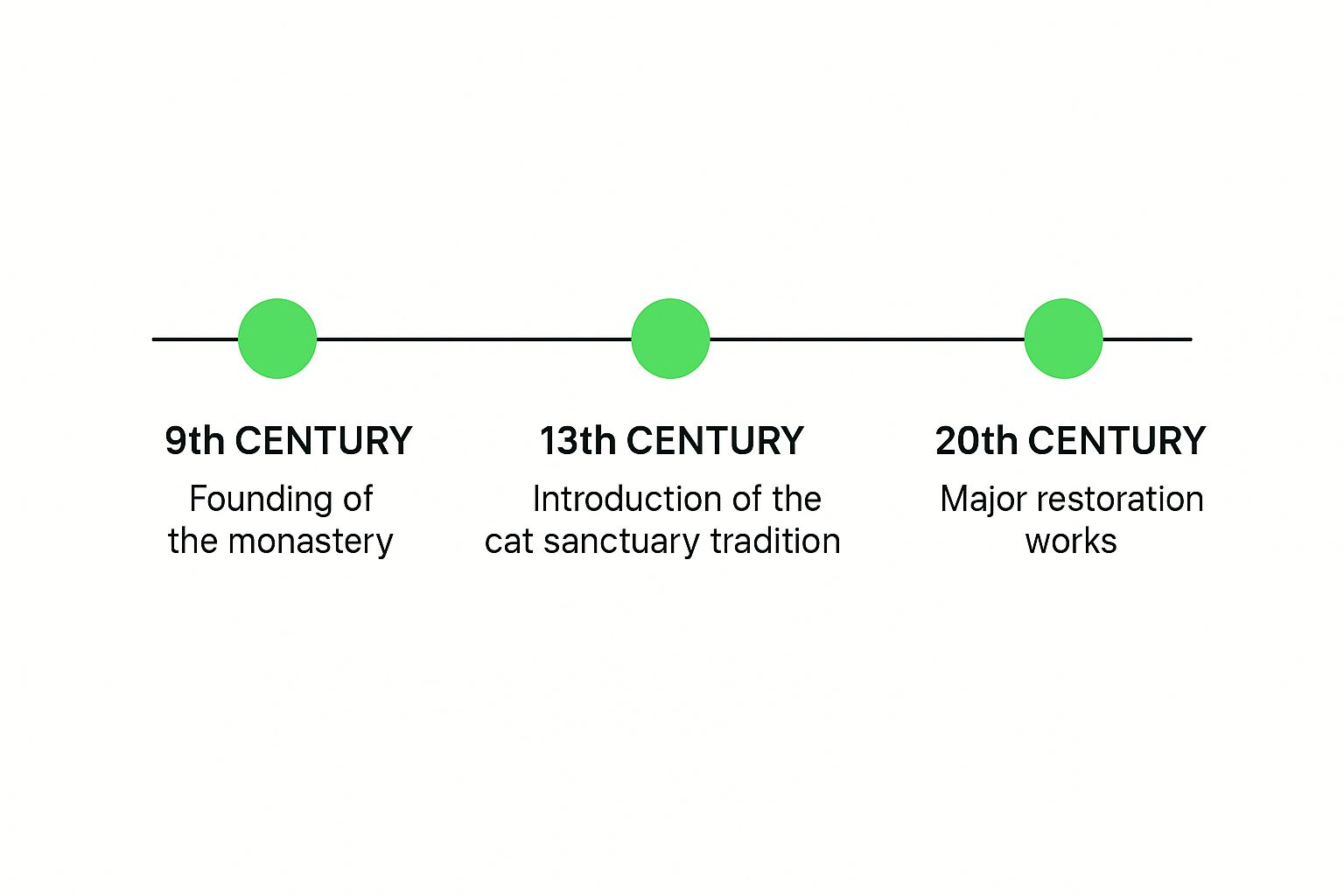
You can see the huge gaps between major events, which just goes to show how resilient this place has been, surviving long periods of neglect before being brought back to life.
A Unique Place in Modern History
What's really fascinating today is its location. The monastery sits squarely within one of the British Sovereign Base Areas, yet its religious and architectural character remains completely, authentically Cypriot Orthodox. The church itself dates back to the 1200s, with its founding legend stretching all the way back to the 4th century. Unlike so many other religious sites caught up in geopolitical shifts, its spiritual life has carried on undisturbed, preserving its ancient traditions. You can read more about its uninterrupted religious history on stnicholascenter.org.
It's a truly unique historical case study. The monastery has weathered the rule of Lusignans, Venetians, and Ottomans, and now sits inside a British territory, yet its core identity as an Orthodox sanctuary has never wavered.
Today, the nuns continue the monastery's traditions, including the much-loved duty of looking after the resident cats. They have seamlessly woven the legendary past into the fabric of daily life. This incredible story of survival gives you a new appreciation for the island's layered past. If you're exploring the area, our guide to the most interesting places to see in Paphos offers more insight into Cyprus's rich history. Ultimately, the story of St Nicholas of the Cats isn't just about surviving; it's about a powerful spiritual legacy that endures.
Exploring the Architecture and Sacred Grounds
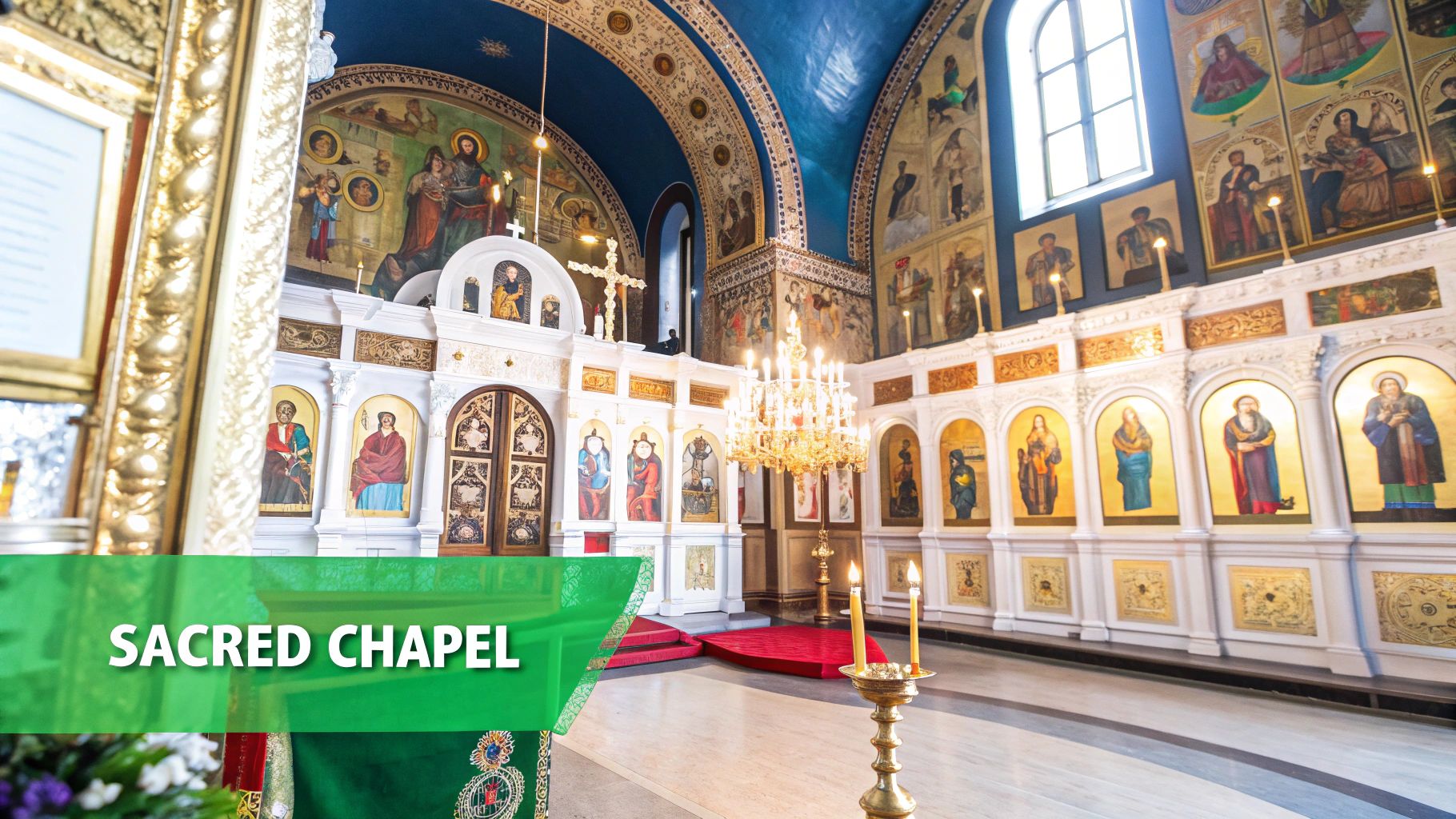
When you first step through the gates of the Holy Monastery of St Nicholas of the Cats, you'll immediately sense you've entered another time. This isn't a grand, imposing complex; instead, it has a quiet strength and a deep-rooted tranquillity, built from the warm, honey-coloured stone so typical of the Cypriot landscape.
The entire site is wrapped in weathered stone walls, creating a real sense of sanctuary from the outside world. Once you’re inside, you find yourself in a peaceful central courtyard. It’s a lovely, calm space where potted plants, shady trees, and the famous feline residents create an atmosphere perfect for a moment of quiet reflection.
The Heart of the Monastery: The Church
Standing proudly in the centre of the courtyard is the main church, a modest but beautiful structure dedicated to Saint Nicholas. It’s built in a simple, single-aisled basilica style, and its architecture is a pure reflection of centuries of Orthodox tradition. The exterior is humble, almost beckoning you to come inside and discover the spiritual richness held within.
The church interior offers an intimate and deeply reverent experience. Your eyes are immediately drawn to the iconostasis—that ornate, icon-covered screen separating the main body of the church from the sanctuary. It’s covered in beautifully painted icons, each depicting key figures and scenes from the Christian faith and each considered a window into the divine. The air is thick with the faint, sweet scent of incense, a smell that feels as if it has seeped into the very stones over generations.
The interior isn't designed to overwhelm you with its size. Rather, it’s meant to encourage a personal connection with the divine. Every artefact, from the silver-clad icons to the embroidered cloths on the altar, serves a purpose in Orthodox worship and tells a story of enduring devotion.
The church's layout is quite characteristic of many historic Cypriot religious sites. For anyone interested in comparing the different monastic styles on the island, our guide to the magnificent Ayia Napa Monastery offers a fascinating contrast in both scale and history.
The Courtyards and Feline Haunts
Beyond the church, the monastery grounds unfold into a delightful maze of smaller courtyards, little gardens, and winding pathways. It's in these areas that you're most likely to meet the famous cats, who have made every sun-drenched nook and cranny their own. You’ll find them napping on warm stones, perched on ancient ledges, or confidently weaving through the legs of visitors.
The gardens themselves are simple but well-cared-for, adding welcome splashes of green and colour to the stone surroundings. Benches have been thoughtfully placed under olive and citrus trees, offering quiet spots to just sit and soak up the unique spirit of the place. The entire layout seems designed to encourage a slow, contemplative pace, making it a perfect escape.
How to Plan Your Visit to the Cat Monastery
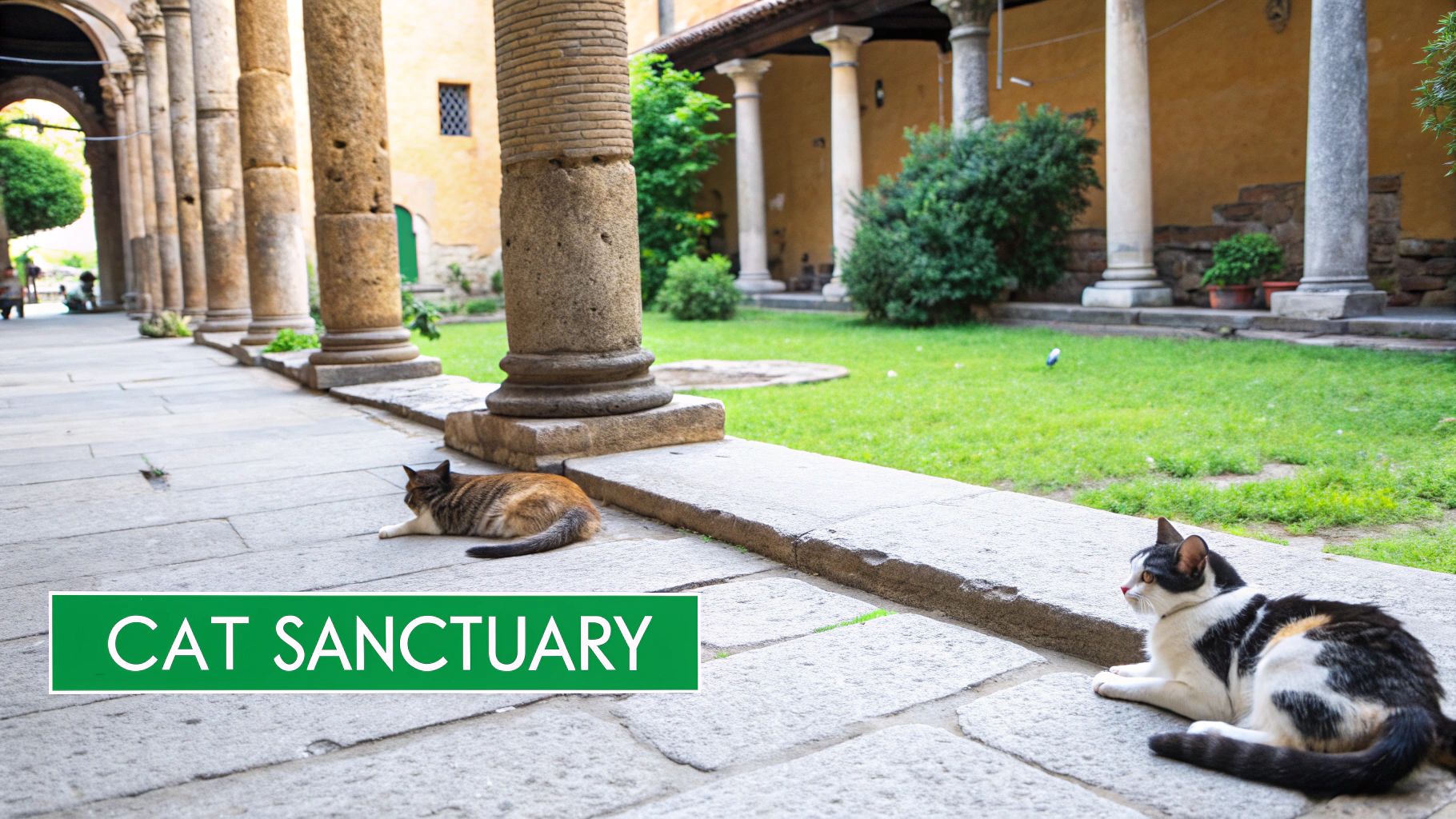
A trip to the Holy Monastery of St Nicholas of the Cats offers a truly memorable experience, blending ancient history with the quirky charm of its famous feline residents. To get the most out of your day, a little bit of planning will make all the difference. Here’s everything you need to know to make your visit seamless and respectful.
Getting There
You'll find the monastery tucked away on the Akrotiri Peninsula, just a short drive from Limassol. It sits near the magnificent Akrotiri Salt Lake, so it’s a perfect addition to a day spent exploring the area's natural wonders.
Without a doubt, driving is the easiest way to reach this secluded spot. From Limassol, just follow the road signs towards Akrotiri village, and you'll soon see signs pointing you directly to the monastery.
If you're coming from further afield, say, flying into Paphos, it's a good idea to sort out your transport beforehand. Looking into a pre-booked Paphos airport transfer can take the hassle out of the journey and get your Cypriot adventure started on the right foot.
What to Know Before You Go
To help you plan, here's a quick rundown of the essential information for visiting the monastery.
| Visitor Information for St Nicholas of the Cats Monastery |
| :—————————————————— | :———————————————————————————————————————————————————————————————— |
| Information | Details |
| Opening Hours | Times can vary by season. The monastery is generally open daily but often closes for a couple of hours mid-afternoon. It’s always best to check locally for the most current times before you head out. |
| Entrance Fee | There is no entrance fee to visit. However, donations are warmly welcomed and go towards supporting the nuns and the ongoing care of the monastery's many cats. |
| Dress Code | As a place of worship and a functioning convent, a respectful dress code is essential. Shoulders and knees must be covered for all visitors, regardless of gender. |
| Photography | You can take photos in the courtyard and of the exterior, but photography inside the church itself is usually not permitted. Look for signs or ask politely if you are unsure. |
Remember, this is not just a tourist attraction; it's a sacred space and the home of a religious community. Following these simple guidelines ensures a pleasant visit for everyone.
Visitor Etiquette and Tips
As this is an active convent, dressing modestly is a fundamental sign of respect.
Think of it this way: you are a guest in someone's home—a home dedicated to quiet devotion. Covering your shoulders and knees is a simple gesture that acknowledges their way of life. If you're caught short, don't worry, as they often have skirts available at the entrance.
To really soak in the peaceful atmosphere, here are a few final tips:
- Best Time to Visit: Try to go on a weekday morning. You'll find it far less crowded than on weekends, and the gentle morning light is just perfect for photos.
- Saying Hello: The nuns are often occupied with their daily duties, but they are welcoming. A quiet, friendly greeting is always appreciated. As for the cats, they are the true stars of the show! Most are very friendly and used to people, so feel free to give them a gentle stroke, but always let them come to you.
- What to Bring: Cyprus gets hot, especially in summer. Pack a bottle of water, sun cream, and a hat, as the beautiful courtyard offers little shade. And, of course, don’t forget your camera
Your Visit: What to Know Before You Go
A trip to the Holy Monastery of St Nicholas of the Cats is a pretty relaxed affair, but a little bit of planning always helps make things go smoothly. If you're wondering about the practicalities of a visit, you're in the right place. We've put together some answers to the questions we hear most often from first-time visitors.
Think of this as a friendly guide to help you get the most out of your time here, covering everything from what to wear to how you can show your support for this unique sanctuary and its famous furry residents.
Is There a Specific Dress Code?
Yes, and it’s something to take seriously. This is a working monastery and a sacred place for the nuns who live here, so dressing modestly is a simple sign of respect. Like in most Orthodox churches, the main rule is to keep your shoulders and knees covered.
It’s less about strict rules and more about being a considerate guest. A little thought goes a long way in honouring the community’s way of life.
- For women: A long skirt, dress, or trousers that go past the knee are perfect. It’s also a good idea to bring a light scarf or cardigan to cover your shoulders.
- For men: Long trousers are a must—shorts aren't allowed on the grounds. A regular t-shirt is fine, just avoid sleeveless tops.
Don't panic if you show up in your beach gear, though. The monastery usually has a supply of simple wrap-around skirts and shawls at the entrance for visitors to borrow.
Can Visitors Pet the Monastery Cats?
Of course! The cats are the real celebrities here, and they’re completely used to having people around. Most of them are incredibly placid and will happily accept a gentle stroke or a scratch behind the ears. You’ll see them dozing in the sun, patrolling the courtyards, and sometimes even coming right up to you for a bit of fuss.
That said, it’s always best to let the cat make the first move. They’re still animals, after all. Just approach them calmly, without any sudden movements, and they’ll likely be your best friend.
The gentle relationship between the nuns, the visitors, and the cats is what makes this place so special. Treating the animals with kindness is part of honouring the monastery’s unique story.
For many people, getting to spend a few moments with these cats is the highlight of their visit and a real connection to its living history.
How Much Time Should I Set Aside for My Visit?
To really soak it all in without rushing, you’ll want to give yourself about one to one-and-a-half hours. That’s plenty of time to experience everything the monastery has to offer.
In that time, you can:
- See the Church: Step inside the beautiful 13th-century church, admire its icons, and just enjoy the quiet, peaceful atmosphere.
- Explore the Grounds: Wander through the lovely stone courtyards and gardens, perhaps finding a quiet bench to sit for a moment.
- Meet the Cats: This is a big part of the experience, so leave plenty of time to say hello to the feline residents.
- Pop into the Shop: Have a look at the handmade goods and religious souvenirs for sale.
It's not a huge place, but its real charm is in its tranquillity. You'd miss the whole point if you tried to speed through it.
Can I Support the Monastery?
Yes, and any support is always warmly welcomed. There’s no official entrance fee to visit the Monastery of St Nicholas of the Cats, but there are a couple of simple ways you can contribute to its upkeep and help care for both the nuns and the cats.
You'll find a donation box where you can leave a contribution. The money goes straight towards maintaining the historic buildings and supporting the community.
The other great way to help is by making a purchase from the small on-site shop. It's a chance to take home a lovely, authentic souvenir while giving something back. They usually sell things like:
- Handmade jams and locally produced honey.
- Religious icons, prayer ropes, and crosses.
- Incense and other small devotional gifts.
Every little purchase makes a real difference in helping to preserve this incredible sanctuary.




